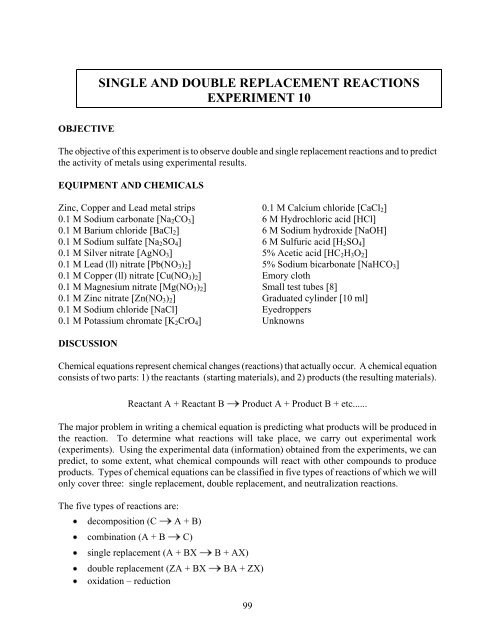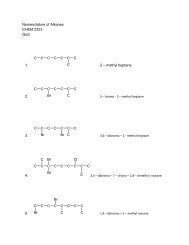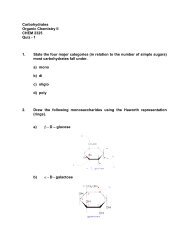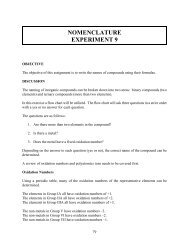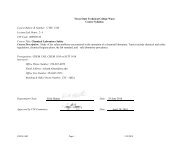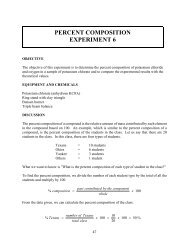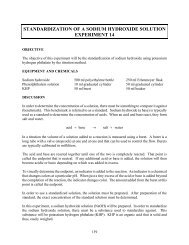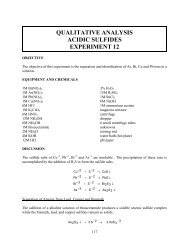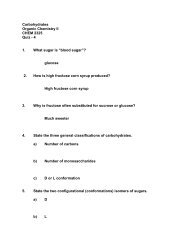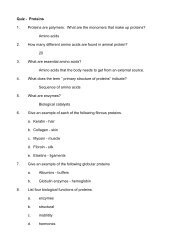single and double replacement reactions experiment 10
single and double replacement reactions experiment 10
single and double replacement reactions experiment 10
Create successful ePaper yourself
Turn your PDF publications into a flip-book with our unique Google optimized e-Paper software.
SINGLE AND DOUBLE REPLACEMENT REACTIONS<br />
EXPERIMENT <strong>10</strong><br />
OBJECTIVE<br />
The objective of this <strong>experiment</strong> is to observe <strong>double</strong> <strong>and</strong> <strong>single</strong> <strong>replacement</strong> <strong>reactions</strong> <strong>and</strong> to predict<br />
the activity of metals using <strong>experiment</strong>al results.<br />
EQUIPMENT AND CHEMICALS<br />
Zinc, Copper <strong>and</strong> Lead metal strips<br />
0.1 M Sodium carbonate [Na 2 CO 3 ]<br />
0.1 M Barium chloride [BaCl 2 ]<br />
0.1 M Sodium sulfate [Na 2 SO 4 ]<br />
0.1 M Silver nitrate [AgNO 3 ]<br />
0.1 M Lead (ll) nitrate [Pb(NO 3 ) 2 ]<br />
0.1 M Copper (ll) nitrate [Cu(NO 3 ) 2 ]<br />
0.1 M Magnesium nitrate [Mg(NO 3 ) 2 ]<br />
0.1 M Zinc nitrate [Zn(NO 3 ) 2 ]<br />
0.1 M Sodium chloride [NaCl]<br />
0.1 M Potassium chromate [K 2 CrO 4 ]<br />
0.1 M Calcium chloride [CaCl 2 ]<br />
6 M Hydrochloric acid [HCl]<br />
6 M Sodium hydroxide [NaOH]<br />
6 M Sulfuric acid [H 2 SO 4 ]<br />
5% Acetic acid [HC 2 H 3 O 2 ]<br />
5% Sodium bicarbonate [NaHCO 3 ]<br />
Emory cloth<br />
Small test tubes [8]<br />
Graduated cylinder [<strong>10</strong> ml]<br />
Eyedroppers<br />
Unknowns<br />
DISCUSSION<br />
Chemical equations represent chemical changes (<strong>reactions</strong>) that actually occur. A chemical equation<br />
consists of two parts: 1) the reactants (starting materials), <strong>and</strong> 2) products (the resulting materials).<br />
Reactant A + Reactant B<br />
Product A + Product B + etc......<br />
The major problem in writing a chemical equation is predicting what products will be produced in<br />
the reaction. To determine what <strong>reactions</strong> will take place, we carry out <strong>experiment</strong>al work<br />
(<strong>experiment</strong>s). Using the <strong>experiment</strong>al data (information) obtained from the <strong>experiment</strong>s, we can<br />
predict, to some extent, what chemical compounds will react with other compounds to produce<br />
products. Types of chemical equations can be classified in five types of <strong>reactions</strong> of which we will<br />
only cover three: <strong>single</strong> <strong>replacement</strong>, <strong>double</strong> <strong>replacement</strong>, <strong>and</strong> neutralization <strong>reactions</strong>.<br />
The five types of <strong>reactions</strong> are:<br />
decomposition (C A + B)<br />
combination (A + B C)<br />
<strong>single</strong> <strong>replacement</strong> (A + BX<br />
<strong>double</strong> <strong>replacement</strong> (ZA + BX<br />
oxidation – reduction<br />
B + AX)<br />
BA + ZX)<br />
99
SINGLE REPLACEMENT REACTIONS<br />
In a <strong>single</strong> <strong>replacement</strong> reaction, one element reacts with a compound to produce a new compound,<br />
<strong>and</strong> displaces an element in the original compound.<br />
A + BX B + AX<br />
(<strong>single</strong> <strong>replacement</strong> reaction)<br />
If A is a metal, it will replace the element B in the compound BS to form a new compound AX. The<br />
element B is now a free metal. The reaction will occur if A is more active than the element B. We<br />
can <strong>experiment</strong>ally establish this "pecking" order. By knowing which elements are at the top of the<br />
list, we can predict whether or not a reaction will occur. The elements on the top of the list (left<br />
side) will replace any element underneath it (right side) on the list.<br />
increasing reactivity<br />
K Ca Al Fe Sn Hg Pt<br />
For example, if Ca metal was placed in a solution of tin (ll) nitrate, the Ca would dissolve <strong>and</strong> the tin<br />
metal would come out of solution.<br />
This is a typical <strong>single</strong> <strong>replacement</strong> reaction.<br />
Ca + Sn(NO 3 ) 2 Sn + Ca(NO 3 ) 2<br />
If the free metal is lower on the list (less reactive) than the metal attached to the anion, no reaction<br />
would occur (NR).<br />
Pt + FeCl 2<br />
By setting up numerous <strong>reactions</strong> of the type, an activity series can be determined.<br />
DOUBLE REPLACEMENT REACTIONS<br />
In a <strong>double</strong> <strong>replacement</strong> reaction, two compounds react with each other to produce two new<br />
compounds. In this type of reaction, the metals just exchange positions.<br />
NR<br />
AX + BZ BX + AZ<br />
(<strong>double</strong> <strong>replacement</strong> reaction)<br />
The metal is on A replaces the metal ion B <strong>and</strong> vice versa. To determine whether a reaction takes<br />
places, some form of physical change must be observed. The most typical types of changes are:<br />
<strong>10</strong>0
precipitate (solid comes out of solution)<br />
gas evolved (bubbles)<br />
change in temperature (hot or cold)<br />
change in colour<br />
Sometimes <strong>reactions</strong> take place very slowly <strong>and</strong> no physical changes are rapidly observed. In this<br />
case more complicated techniques, which are out of the scope of this <strong>experiment</strong>, must be employed.<br />
Typical examples of <strong>double</strong> <strong>replacement</strong> <strong>reactions</strong> are:<br />
BaCl 2 + 2AgNO 3<br />
Ba(NO 3 ) 2 + AgCl<br />
HCl + ZnS<br />
CaO + 2HCl<br />
ZnCl 2 + H 2 S<br />
CaCl 2 + H 2 O + heat<br />
NEUTRALIZATION REACTIONS<br />
KSCN + FeCl 3 FeSCN + KCl (unbalanced)<br />
(changes from yellow to deep red)<br />
Neutralization <strong>reactions</strong> are really <strong>double</strong> <strong>replacement</strong> <strong>reactions</strong> but are unique. Neutralization<br />
occurs when an acidic compound (contains H + ) reacts with a basic compound (OH - ) to produce a salt<br />
<strong>and</strong> water. Normally these types of <strong>reactions</strong> proceed with a change in temperature.<br />
HX + BOH<br />
BX + HOH<br />
A typical example of this is the addition of HCl with NaOH.<br />
HCl + NaOH<br />
NaCl + HOH + heat<br />
The salt formed is sodium chloride (NaCl) <strong>and</strong> water (HOH).<br />
PROCEDURE<br />
PART A - SINGLE REPLACEMENT REACTIONS<br />
In a <strong>single</strong> <strong>replacement</strong> reaction, an element replaces another element in a compound. Evidence of<br />
reaction is a gas being evolved, a change in colour of the solution, metals being deposited on the<br />
elemental metal, or precipitates.<br />
1. Obtain six pieces of an unknown metal from your instructor <strong>and</strong> record the unknown number<br />
on your Report Sheet.<br />
2. Obtain six pieces of Zn metal, six pieces of Pb metal, six pieces of Cu metal, <strong>and</strong> six pieces<br />
of unknown from the chemical bench.<br />
<strong>10</strong>1
3. Polish each piece (including your unknown) with a piece of emory cloth. This will remove<br />
any oxides <strong>and</strong> expose the metal surfaces.<br />
4. Label four (4) small tubes as<br />
(1) Zn<br />
(2) Pb<br />
(3) Cu<br />
(4) UNK<br />
5. Add 5 ml of 0.1M AgNO 3 to each tube. Add a piece of metal to each test tube that<br />
corresponds to the label on the test tube. Allow ten minutes for each reaction. Record<br />
results on Report Sheet.<br />
6. Label a second set of small test tubes<br />
(1) Zn<br />
(2) Pb<br />
(3) Cu<br />
(4) Unknown<br />
7. Add 5 ml of 0.1M Cu(NO 3 ) 2 to each tube <strong>and</strong> add the metal pieces to the corresponding<br />
test tubes. Report any <strong>reactions</strong> on your Report Sheet.<br />
8. Clean <strong>and</strong> rinse the first set of test tubes that were used in Step 4. Repeat the <strong>experiment</strong><br />
using 5 ml of 0.1M Pb(NO 3 ) 2 . Report any <strong>reactions</strong> on your Report Sheet.<br />
9. Clean <strong>and</strong> rinse the second set of test tubes that were used in Step 6. Repeat the <strong>experiment</strong><br />
using 5 ml of 0.1 Mg(NO 3 ) 2 . Report any <strong>reactions</strong> on your Report Sheet.<br />
<strong>10</strong>. Clean <strong>and</strong> rinse the set of test tubes used in Step 8. Repeat the <strong>experiment</strong> using 5 ml of 6M<br />
H 2 SO 4 . Report any <strong>reactions</strong> on your Report Sheet.<br />
11. Clean <strong>and</strong> rinse the set of test tubes used in Step 9. Repeat the <strong>experiment</strong> using 5 ml of<br />
0.1M Zn(NO 3 ) 2 .<br />
12. Using the data obtained from Steps 1-11, write a balanced equation for each reaction that<br />
showed evidence of a <strong>single</strong> <strong>replacement</strong> reaction. Use NR for any non-<strong>reactions</strong>.<br />
13. Based on the data, assign an activity order to each of the metals <strong>and</strong> solutions tested.<br />
PART B - DOUBLE REPLACEMENT REACTIONS<br />
Double <strong>replacement</strong> <strong>reactions</strong> involve two compounds with the positive cation of one compound<br />
exchanging positions with the cation of the other compound. In order to recognize whether or not a<br />
reaction takes place, a precipitate, a change in temperature, or gas evolution must be observed.<br />
<strong>10</strong>2
1. Add 3 ml of 0.1M NaCl to a small test tube. Add an additional 3 ml of 0.1M AgNO 3 to the<br />
test tube. Observe any changes that occur <strong>and</strong> record on your Report Sheet. Remember to<br />
feel the test tube for any change in temperature.<br />
2. Add 3 ml of 0.1M Pb(NO 3 ) 2 to a small test tube. Add an additional 3 ml of 0.1M K 2 CrO 4<br />
solution. Observe any changes <strong>and</strong> record on your Report Sheet.<br />
3 Add 3 ml of 0.1M CaCl 2 to a small test tube. Add an additional 3 ml of 0.1M Na 2 CO 3 .<br />
Record any observations on your Report Sheet.<br />
4. Add 3 ml of 0.1M BaCl 2 to the small test tube. Add an additional 3 ml of 0.1M Na 2 SO 4 <strong>and</strong><br />
record any observations on your Report Sheet.<br />
5. Add 3 ml of 5% NaHCO 3 to the small test tube. Add 3 ml of 5% acetic acid, <strong>and</strong> record any<br />
observations on your Report Sheet.<br />
6. Add 3 ml of 6M HCl to a small test tube, <strong>and</strong>, dropwise, add an additional 3 ml of 6M<br />
NaOH. Record any observations of your Report Sheet.<br />
7. What types of <strong>reactions</strong> did you observe in Part B?<br />
<strong>10</strong>3
<strong>10</strong>4<br />
This page left intentionally blank.
NAME _______________________<br />
DATE ________________________<br />
SECTION _____________________<br />
SINGLE AND DOUBLE REPLACEMENT REACTIONS<br />
REPORT SHEET<br />
EXPERIMENT <strong>10</strong><br />
SINGLE REPLACEMENT REACTIONS<br />
1. If any evidence of a reaction occurs, place an "R" in the appropriate box. If no evidence of<br />
reaction was observed, place a "NR" in the appropriate box.<br />
Metal<br />
Compound Zn Pb Cu Unk<br />
Ag NO 3<br />
Cu(NO 3 ) 2<br />
Pb(NO 3 ) 2<br />
Mg(NO 3 ) 2<br />
H 2 SO 4<br />
Zn(NO 3 ) 2<br />
2. Using the above information write <strong>and</strong> balance an equation for each reaction that took place.<br />
If no reaction occurred, write "NR". Refer to Appendix l for valences <strong>and</strong> charges.<br />
a) Zn + AgNO 3<br />
b) Pb + AgNO 3<br />
c) Cu + AgNO 3<br />
d) Zn + Cu(NO 3 ) 2<br />
e) Pb + Cu(NO 3 ) 2<br />
f) Zn + Pb(NO 3 ) 2<br />
<strong>10</strong>5
g) Cu + Pb(NO 3 ) 2<br />
h) Zn + Mg(NO 3 ) 2<br />
i) Pb + Mg(NO 3 ) 2<br />
j) Cu + Mg(NO 3 ) 2<br />
k) Zn + H 2 SO 4<br />
l) Pb + H 2 SO 4<br />
m) Cu + H 2 SO 4<br />
n) Pb + Zn(NO 3 ) 2<br />
o) Cu + Zn(NO 3 ) 2<br />
3. Based on the above information, assign an activity order to each of the metals with the most<br />
active metal as number 1.<br />
______ ______ ______ ______ ______ ______<br />
1 2 3 4 5 6<br />
4. Where would your unknown be located in the above activity series?<br />
DOUBLE REPLACEMENT REACTION<br />
1. a) Describe what happens when the AgNO 3 solution was added to the NaCl solution?<br />
b) What evidence of reaction was observed?<br />
c) Write a balanced equation for the above reaction.<br />
<strong>10</strong>6
2. a) Describe what happens when the Pb(NO 3 ) 2 solution was added to the K 2 CrO 4<br />
solution.<br />
b) What evidence of reaction was observed?<br />
c) Write a balanced equation for the above reaction.<br />
3. a) Describe what happens when the CaCl 2 solution is added to the Na 2 CO 3 solution.<br />
b) What evidence of reaction was observed?<br />
c) Write a balanced equation for the above reaction.<br />
4. a) Describe what happens when the BaCl 2 solution is added to the Na 2 SO 4 solution.<br />
b) What evidence of reaction was observed?<br />
c) Write a balanced equation for the above reaction.<br />
<strong>10</strong>7
5. a) Describe what happens when the acetic acid solution is added to the sodium<br />
bicarbonate solution.<br />
b) What evidence of reaction was observed?<br />
c) Write a balanced equation for the above reaction.<br />
6. a) Describe what happens when sodium hydroxide solution is added to the hydrochloric<br />
acid solution.<br />
b) What evidence of reaction was observed?<br />
c) Write a balanced equation for the above reaction.<br />
7. What three types of observations indicate a reaction has taken place in Part B?<br />
a)<br />
b)<br />
c)<br />
<strong>10</strong>8


